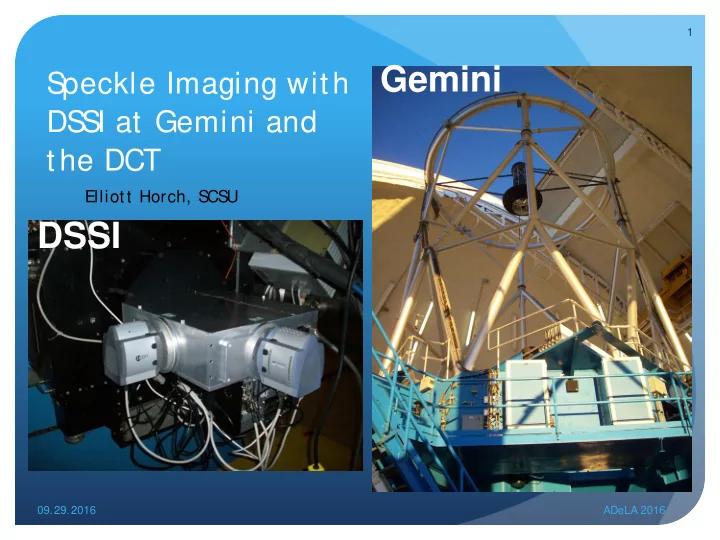

1 Gemini S peckle Imaging with DS S I at Gemini and the DCT Elliott Horch, S CS U DSSI 09.29.2016 ADeLA 2016
2 S peckle Imaging is “ S ingle-Aperture” Interferometry In each exposure, t he effect of at mospheric t urbulence is “ frozen.” If t he obj ect is double, t hen t here are “ double speckles.” Image reconst ruct ion via bispect ral analysis. Fast : no observing overhead. Baselines are redundant . S peckle has been responsible for many high-qualit y binary st ar orbit s over t he years. 09.29.2016 ADeLA 2016
3 EMCCDs Photon counting performance with high quantum efficiency. Clocking accumulated charge through a series of gain registers builds up signal prior to reading out through the charge amplifier sub-electron read noise. 09.29.2016 ADeLA 2016
4 S ome S peckle Cameras in Current Use 09.29.2016 ADeLA 2016
5 A Uniquely Capable S peckle Imager Built at S CS U Telescope Focal Plane Collimat ing Lens ( L1 ) Space for Risley Prisms Electronics Bay Dichroic Beam Filter ( F1 ) S plit t er ( S1 ) EMCCD 1 Reimaging Lens ( L2 ) Filter ( F2 ) Tip-Tilt Mirrors Reimaging Lens ( L3 ) ( M1,M2 ) EMCCD 2 09.29.2016 ADeLA 2016
6 What the DS S I Camera Does 1 arcsec 09.29.2016 ADeLA 2016
7 Gemini-N Used 2012-present, official visiting instrument, 4 different science projects on last run. (Jan 2016) Gemini WIYN 09.29.2016 ADeLA 2016
8 Some Representative Projects K-Kids. Finding companions to K-type main sequence stars. GOAL: G, M stars have been characterized but not K stars. If the rate of binarity is different for K stars, it will have implications for star formation. (T. Henry, E. Horch) Kepler survey. Finding companions to KOIs and K2 objects. GOAL: Characterize fraction of exoplanet systems that have stellar companions. (S. Howell, E. Horch) Observing secondaries of known “wide” binaries – finding companions. (A. Tokovinin, E. Horch) GOAL: will yield info on star formation processes. Metal-Poor Binaries. (W. van Altena, P. Demarque ,E. Horch) GOAL: Characterize “Second Parameters” of Mass-Luminosity Relation. 09.29.2016 ADeLA 2016
9 K-Kids Poster Children of the Month Data from Lowell Observatory’s Discovery Channel Telescope HIP 11565 HIP 9603 Dist: 19.5 pc Dist: 28.8 pc S eparation: 10 AU S eparation: 6 AU 09.29.2016 ADeLA 2016
10 Companion Detection for Kepler TRILEGAL galaxy model. Look in Kepler field at the appropriate distance range. Use Raghavan 2010 binary/multiple star statistics from the field. Ask with what frequency DSSI would detect Kepler star with a companion. 09.29.2016 ADeLA 2016
11 Gemini: Kepler Stars with Companions Kepler 437 = KOI 3255 09.29.2016 ADeLA 2016
12 Error In Planet Radius 09.29.2016 ADeLA 2016
13 Companion Detection for K2 using AO and speckle Crossfield et al. 2016, 5 σ confidence limits 09.29.2016 ADeLA 2016
14 Andrei’s “ BCs” Courtesy of Andrei Tokovinin, CTIO 09.29.2016 ADeLA 2016
15 Metal-Poor Binaries 09.29.2016 ADeLA 2016
16 What’s new? WIYNS PKL and GEMS PKL Two new “ facilit y” speckle cameras for WIYN and Gemini-N Dual-channel instruments, like DS S I Both will have a “ speckle” mode and a “ wide-field” mode (~1’ x1’ ) Filters: narrowband speckle filters and S loan griz. WIYNS PKL (aka NES S I): engineering t ime t his Oct ober at WIYN. S hare port wit h Hydra, WHIRC. GEMS PKL: engineering in Jan 2017? Will mount t o GCAL unit , will not t ake a current ly used port . 09.29.2016 ADeLA 2016
17 What’s New? S peckle plus Wavefront S ensing S imulation Results of Löbb, 2016. 09.29.2016 ADeLA 2016
18 S peckle plus Wavefront S ensing 09.29.2016 ADeLA 2016
19 What’s New: Gaia DR1 was released earlier this month. A few parallaxes of speckle binaries, but in preparing observing proposals for 2017A, I did not find not many. When will Gaia help with binaries and astrophysics? DR2 (current ly 2017) will cont ain more and bet t er parallaxes t han DR1 but mainly single st ars. DR3 (current ly 2018) orbit s for short er period binaries. DR4 (current ly 2019) first cat alog of non-singles. DR5 (current ly 2022) full ast romet ric, phot omet ric, and RV informat ion, final non-single cat alogs, exoplanet list . While speckle follow-up is unlikely at Gemini in a survey mode, it is a possibility at WIYN, DCT and other 4-m class telescopes. 09.29.2016 ADeLA 2016
20 S ummary S peckle Imaging today: S uccess of DS S I has led t o t he cont ruct ion of t wo new speckle cameras available t o t he communit y at WIYN and Gemini. Many science proj ect s: S t ars are import ant again! Biggest impact : finding and charact erizing st ellar companions t o exoplanet syst ems. Can we make speckle even better? Incorporat e wavefront sensor informat ion. Wide-field fast imaging. S peckle follow-up can be used on Gaia binaries in the coming years. 09.29.2016 ADeLA 2016
Recommend
More recommend